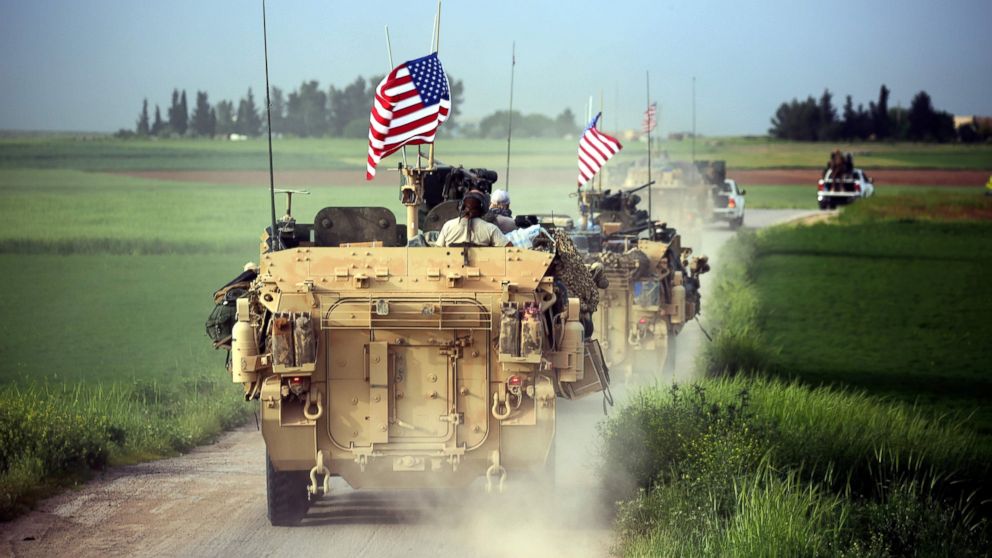[ad_1]
Exactly one year ago, on April 6, 2017, between 8:40 and 8:50 p.m. EDT, 59 U.S. Tomahawk missiles rained down on a Syrian airbase.
The missiles — launched from U.S. Navy destroyers in the Mediterranean Sea — were the Trump administration’s direct response to a Syrian sarin gas attack the U.S. says was perpetrated by Syria‘s President Bashar al-Assad days earlier that killed more than 100 Syrian men, women, and children.
President Donald Trump said the strike was in the “vital national security interests” of the U.S. — a massive response meant to send a message to Assad never to use chemical weapons on his own people ever again. Assad has always denied using them.
 Ford Williams/U.S. Navy via Getty Images
Ford Williams/U.S. Navy via Getty Images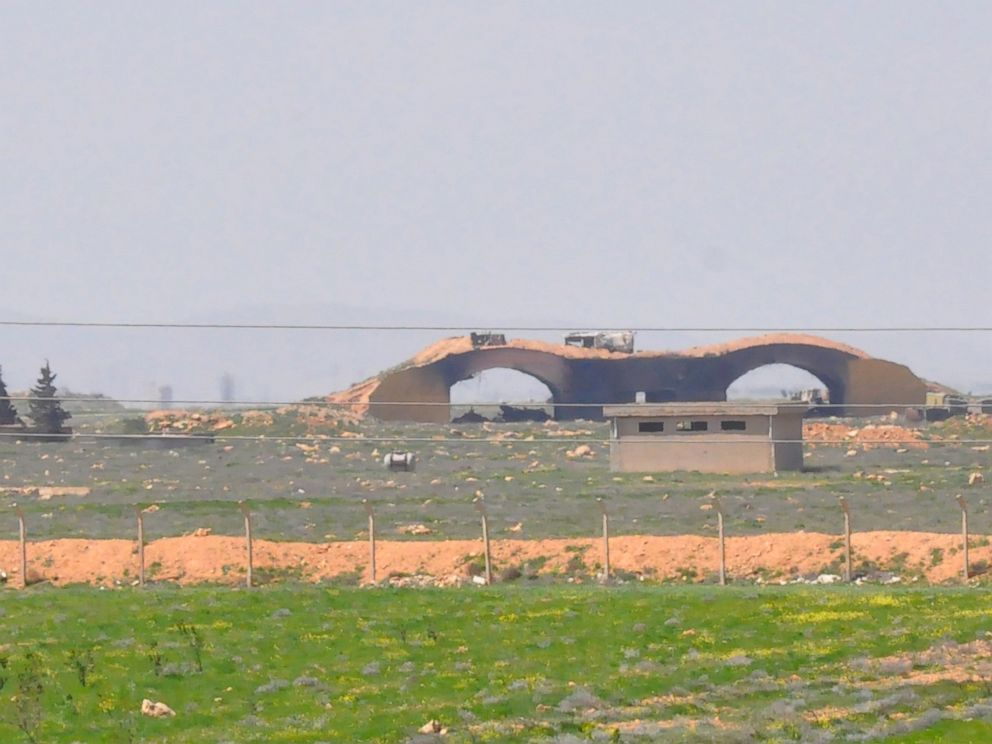 AFP/Getty Images
AFP/Getty ImagesA year later, in its push to retake rebel-held areas in western Syria, the Assad regime has continued to bomb and unleash chemical weapons the U.S. says, but the Trump administration has not been nearly as vocal in its criticism as it was after the attack on Khan Sheikhoun.
Meanwhile, the Assad regime finds itself in a stronger position militarily in western Syria with help from Iranian and Russian forces. On the opposite side of the country, American-backed Kurdish and Arab forces are on the verge of defeating ISIS on the battlefield.
But what comes next after an ISIS defeat?
Trump has signaled to military leaders that he’d like the U.S. to leave Syria “very soon” — a move that could open the door to another chapter in Syria’s devastating and deadly civil war as it enters its eighth year.
ABC News looks at what’s changed — and what hasn’t — in Syria since April 6, 2017.
Chemical attacks continue unabated
In the year since the chemical weapons attack in Khan Sheikhoun that triggered U.S. military action, the Assad regime has continued to gas its own people, the U.S. and advocacy groups say.
Human Rights Watch has estimated the Syrian government to have committed “at least five more chemical weapons attacks” since last April.
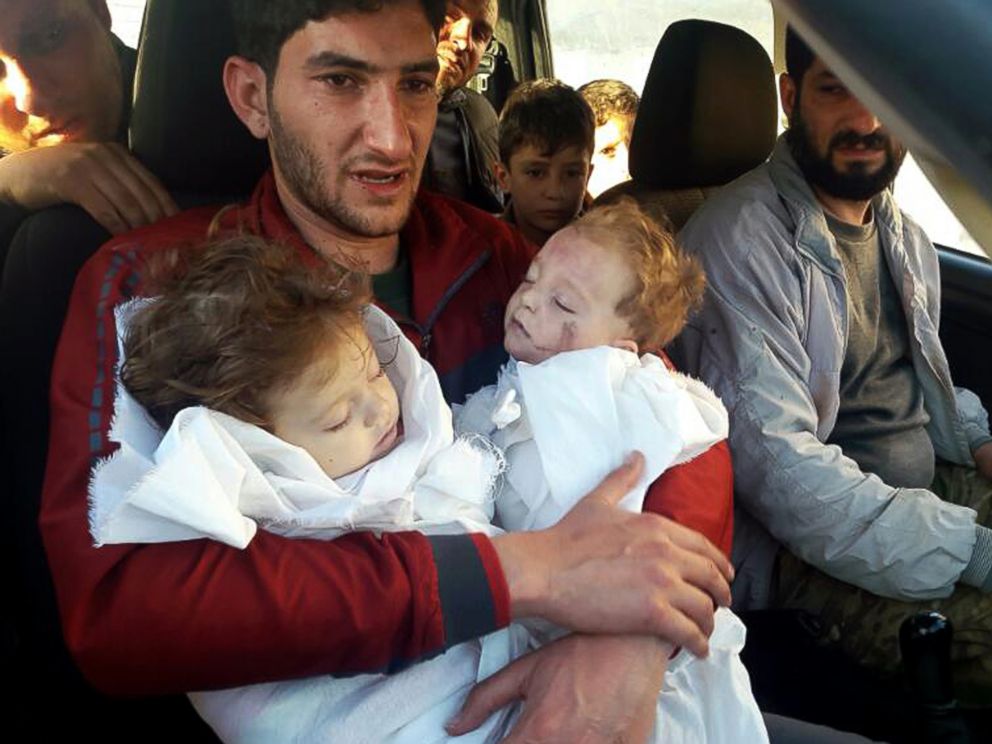 Alaa Alyousef via AP
Alaa Alyousef via APMany of those were conducted in East Ghouta, a suburb of Damascus, where it was reported the government used chlorine against its people earlier this year, according to the Arms Control Association.
Medical facilities supported by Doctors Without Borders said they received over 1,000 dead and 4,800 wounded in East Ghouta between Feb. 18 and March 4 alone.
Syrian strikes continued to hit the city during that time period, despite Russia calling for a truce to allow the 400,000 people living there to leave. The Organization for the Prohibition of Chemical Weapons (OPCW) said it will examine those attacks to determine if chemical weapons were used.
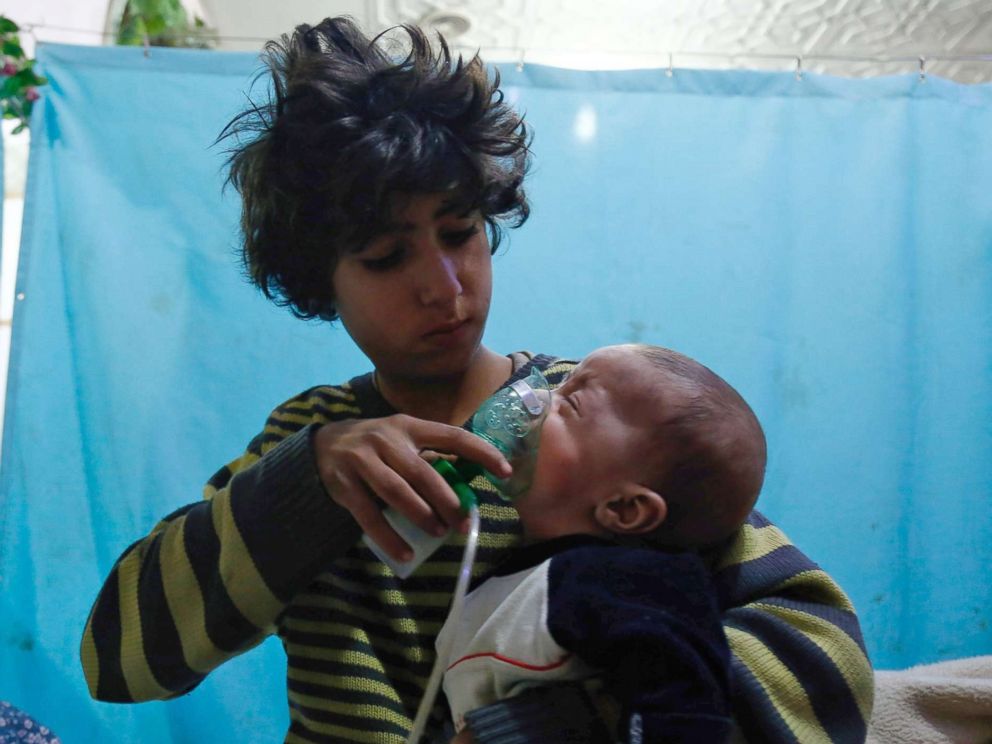 AFP/Getty Images
AFP/Getty ImagesOPCW’s announcement was welcomed by western powers that have hoped to hold the Assad regime accountable.
After the attack in Khan Sheikhoun last year, Russia and China have vetoed UN Security Council resolutions including one that would have referred the case to the International Criminal Court.
A White House statement earlier this week marking one year since the Khan Sheikhoun attack said the people who died that day “deserve justice” and the administration “will not rest until the regime is held accountable.”
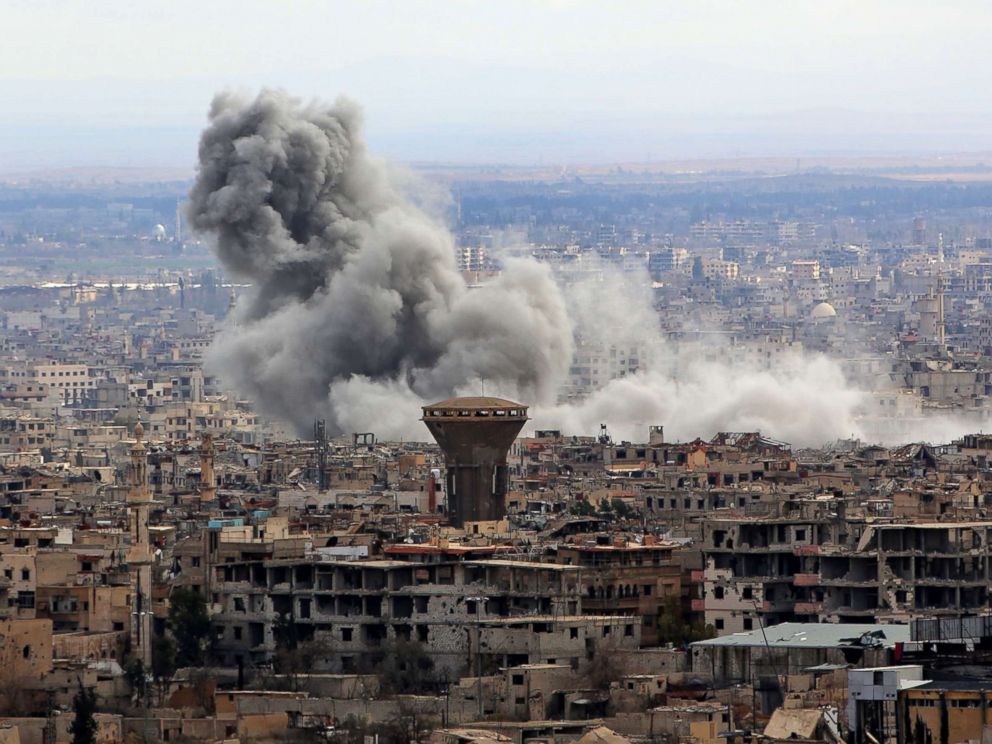 AFP/Getty Images
AFP/Getty ImagesBut even OPCW’s investigation won’t fully assign blame to the Assad regime for the attacks in East Ghouta – only confirm the use of chemical weapons.
“In Syria, the government is using chemical weapons that are banned the world over without paying any price,” said Lama Fakih, deputy Middle East director at Human Rights Watch. “One year after the horrific sarin attack on Khan Sheikhoun, neither the U.N. Security Council nor the Organisation for the Prohibition of Chemical Weapons has acted to uphold the prohibition against chemical weapon attacks.”
Progress in the fight against ISIS
The U.S. has had a military presence in Syria since early 2016 to train and advise Kurdish and Arab rebel forces fighting ISIS in northern and eastern parts of the country. Those troops are backed up by forces from other countries like the United Kingdom and France that make up the anti-ISIS coalition.
Weeks after the U.S. attacked the Syrian airbase, Trump delegated to the Pentagon the authority to set American military troop levels in Iraq and Syria — restoring a process that was in place prior to the Bush and Obama administrations.
At the time, the Pentagon said there would be no change to the official limit of 500 U.S. troops in Syria, but by November, the department acknowledged the American presence had slowly grown to approximately 2,000.
 Hussein Malla/AP
Hussein Malla/APOver the past year, those troops have aided their Kurdish and Arab partner forces, known as the Syrian Democratic Forces (SDF), in making massive strides in the fight against ISIS.
Beginning in May, Trump authorized the U.S. to arm Kurdish elements of the SDF “as necessary” to help retake the city of Raqqa, ISIS’s de-facto capital in Syria.
The move had long been opposed by Turkey, which sees the Kurds as an extension of Kurdish terrorist organizations like the Kurdish Protection Units, which has conducted attacks inside Turkey.
In May, the more than 50,000 member-strong SDF, backed by the coalition, launched the long-awaited offensive to retake Raqqa from ISIS – which had held the city since 2014.
After a battle that left the city largely destroyed, the SDF declared victory on Oct. 20. Since then, a State Department official estimates about 100,000 former residents have returned.
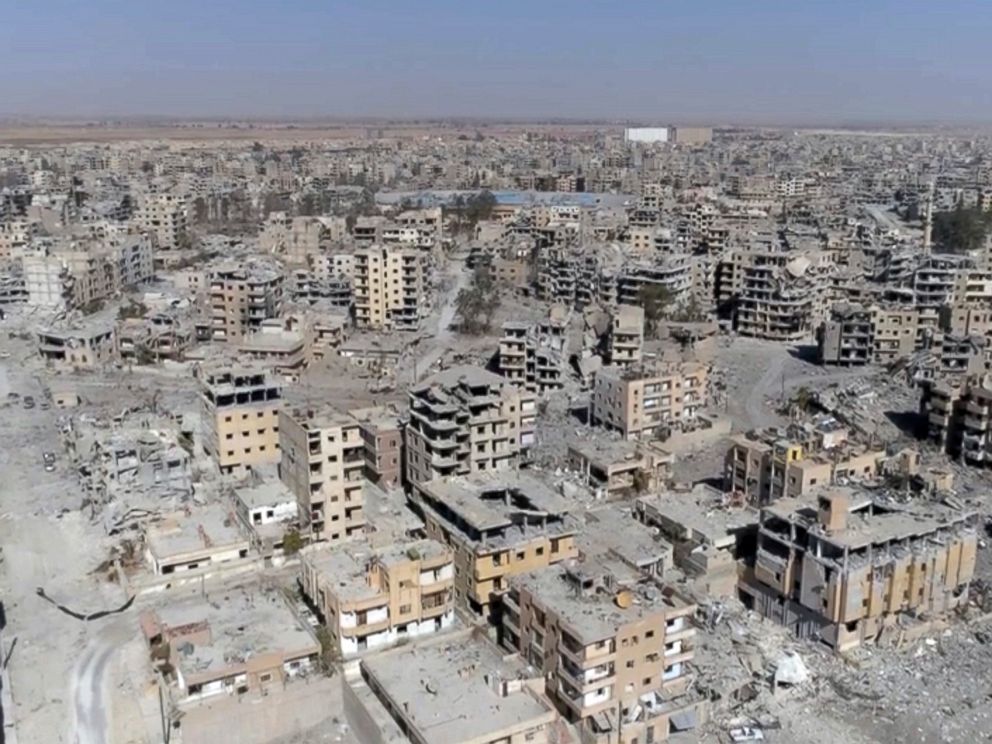 Gabriel Chaim/AP
Gabriel Chaim/APWith the loss of their de-facto capital in Syria, ISIS fighters fled southeast towards the middle Euphrates River Valley close to the Iraq border.
The most recent estimate from the Department of the Defense is that the coalition has retaken about 90 percent of the territory that once belonged to ISIS in Syria.
The military success hasn’t come without cost to American service members.
Since last April, two more American service members have been killed in Syria.
Master Sgt. Jonathan Dunbar, 36, of Austin, Texas was killed in Manbij last week after an improvised explosive device (IED) hit his patrol during a “kill or capture” mission against a known ISIS member. Last May, Spc. Etienne Murphy, 22, of Snellville, Ga., was killed in a vehicle rollover accident.
Crowded territory leads to tension
The U.S.-led fight against ISIS has continuously been distracted by Syrian-, Russian-, and Iranian-affiliated forces, operating in an ever-congested battlespace. At times, the U.S. has had military encounters with each of those forces.
Over the summer, the U.S. conducted airstrikes against Iranian-backed militias and shot down pro-regime drones that encroached on American forces in a remote corner of southern Syria.
Even more dramatically, the U.S. shot down a Syrian aircraft after it dropped a bomb near SDF fighters. It was the first time the U.S. had shot at a manned aircraft since 1999.
In early February, a force that included Russian mercenaries opened fire on U.S. forces east of the Euphrates River, causing the Americans to kill at least “dozens” of Russians, according to the Russian Foreign Ministry.
Then, in March, Defense Secretary James Mattis revealed that Russian mercenaries had again moved into “more advanced positions” than the area of operations agreed upon by the U.S. and Russia.
This time, talks between Chairman of the Joint Chiefs of Staff Gen. Joseph Dunford and his Russian counterpart were able to convince those forces to pull back.
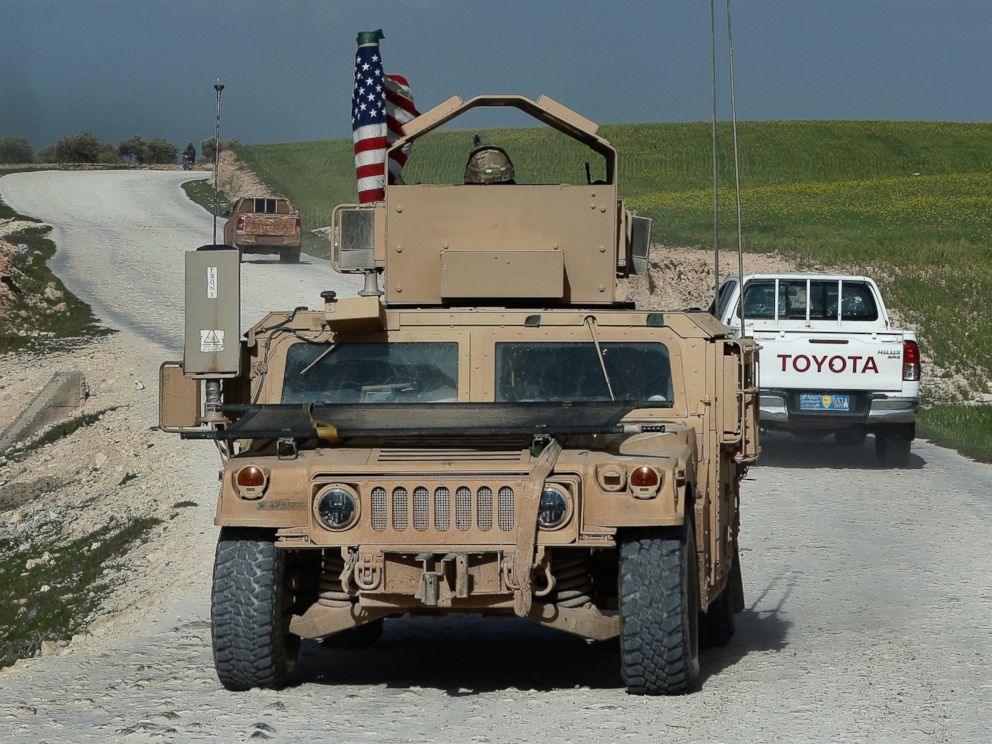 AP
APAnd tensions have increased in northern Syria where a Turkish military incursion has set the stage for a possible battle between Turkey and American-backed Kurdish SDF forces.
Earlier this year, NATO-ally Turkey took over the Kurdish-held city of Afrin in northwestern Syria — with Turkish President Erdogan suggesting his country might expand its military operations against Syrian Kurds elsewhere in northern Syria.
The fight for Afrin has already had a negative impact on the fight against the last remaining pocket of ISIS fighters in eastern Syria. The offensive against ISIS fighters along the border with Iraq has been stalled for weeks as more than 1,500 highly trained Kurdish SDF fighters and commanders headed westward to fight the Turks in Afrin.
If Turkey carries out its threat to push Kurdish fighters out of other areas in northern Syria, it’s possible that even more SDF fighters could leave the fight against ISIS.
Trump wants out as officials stress reconstruction, stabilization efforts
In the past week, Trump has called for U.S. forces to leave Syria “very soon” — statements that his national security team had not expected him to say publicly, according to a senior administration official and a U.S. official familiar with the matter.
But a White House statement issued this week, meant to clarify the U.S. presence there, did not announce an immediate withdrawal of U.S. troops.
“The military mission to eradicate ISIS in Syria is coming to a rapid end, with ISIS being almost completely destroyed,” White House press secretary Sarah Sanders said.
“The United States and our partners remain committed to eliminating the small ISIS presence in Syria that our forces have not already eradicated. We will continue to consult with our allies and friends regarding future plans,” she added.
The statement offered no timeline for a troop withdrawal, nor did it change the U.S. policy in Syria.
The president’s surprising statements made for awkward counter-messaging across town.
 Chip Somodevilla/Getty Images
Chip Somodevilla/Getty ImagesAs Trump was repeating the call for the U.S. to leave Syria, a top U.S. general, diplomat, and development official laid out a strategy for America’s involvement in Syria going forward.
“The hard part, I think, is in front of us,” Gen. Joseph Votel, the U.S. Central Command chief, told an audience at the U.S. Institute of Peace on Tuesday, “and that is stabilizing these areas, consolidating our gains, getting people back into their homes, addressing the long-term issues of reconstruction and other things that will have to be done.”
Accompanying Votel, U.S. Agency for International Development (USAID) Administrator Mark Green and the Special Envoy to the Global Coalition to Defeat ISIS Brett McGurk agreed that what comes after the defeat of ISIS is a key U.S. national security concern.
There are eleven USAID and State Department officials overseeing larger teams that work on de-mining, rubble removal, restoring services like water and electricity, and rebuilding schools and hospitals. The work will allow residents to return to their homes and stabilize the area from becoming a breeding ground for terrorist groups.
The U.N. last estimated in December that about 715,000 people have been able to return to their homes – in part due to these stabilization efforts.
But, the Trump administration continues to send what appear to be mixed signals about those efforts. Last month the Trump administration froze $200 million worth of aid to Syria.
McGurk explained that the U.S. has already spent about $100 million of that amount and the freezing of funds is due to a regular review process to ensure the money is spent most effectively. He added that the coalition has contributed a similar amount of money.
In total, the U.S. has already spent $875 million on stabilization efforts.
On Thursday, Joint Staff Director Lt. Gen. Kenneth McKenzie told reporters the president has “actually been very good in not giving us a specific timeline” for withdrawal.
He added that there was always going to be an adjustment to the U.S. troop presence in Syria after ISIS’s defeat.
“So, in that sense, nothing actually has changed,” McKenzie said of the White House announcement.
A State Department official agreed, telling ABC News on Thursday “there’s no specific timeline” for withdrawal.
“We’re where we were before,” the official said. “The fight against ISIS is our priority in Syria, and we’re committed to that fight until their enduring defeat.”
“Stick around to finish the job, and the president is on board with that,” the official added.
ABC News’ Conor Finnegan and Luis Martinez contributed to this report.
[ad_2]
Source link

